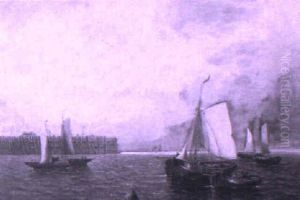Franz Wilhelm Schiertz Paintings
Franz Wilhelm Schiertz was a notable figure in the 19th-century art world, primarily known for his contributions to architecture rather than traditional canvas-based artwork. Born in 1813, Schiertz embarked on his career at a time when the architectural landscape of Europe was undergoing significant transformations, influenced by the industrial revolution and a renewed interest in historical styles, particularly Gothic and Renaissance architecture.
Schiertz's work is characterized by its blend of innovation and reverence for historical architectural principles. Throughout his career, he was deeply involved in several major projects, which included public buildings, churches, and private residences. His approach was often holistic, considering not just the aesthetic aspects of a structure but also its functionality and the role it played within the urban or rural landscape it inhabited.
Despite the challenges of the time, including political upheavals and changing tastes in art and architecture, Schiertz managed to carve out a distinct niche for himself. His dedication to blending form and function, along with a keen eye for detail, set his work apart from many of his contemporaries. Unfortunately, much like many artists and architects of his era, detailed records of his projects and contributions are somewhat scarce, and his name is not as widely recognized in the general public as some of his peers.
Franz Wilhelm Schiertz passed away in 1887, leaving behind a legacy that, while perhaps not as celebrated in popular culture as some of his contemporaries, remains influential among those who study 19th-century European architecture. His work continues to be analyzed and appreciated for its craftsmanship, design, and impact on the evolution of architectural practices in his time.
















